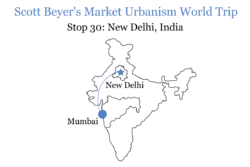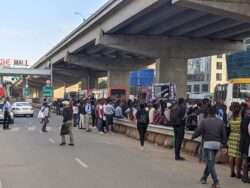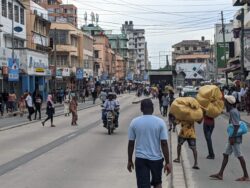How Are Roads Used In a Free Market?
The Third World, such as Gurgaon, India, shows how streets function without any government in place to enforce traffic laws.
Libertarians have long been on the forefront of highway and road policy reform. That’s likely because this infrastructure, in particular, has been used as a gotcha—“but who will build the roads?” It has forced us to develop smart rebuttals on how provision might look in a free-market system.
Various libertarian aligned organizations, including this one, have outlined the benefits of road and curb pricing, a policy now gradually becoming mainstream worldwide. They have also discussed, to a lesser degree, where and what kind of roads get built when left to market forces. Libertarians point to everything from tech-infused private tollways in Texas to the low-standard “forest road” networks built by logging companies. But libertarians talk less about how roads get used absent any government rules. For that answer, they must look beyond the realm of think tanks and institutional financiers, going deep into the Third World.
I’ve found throughout my 1.5-year Global South trip that people in these countries have very different impressions about road usage. For starters, there are not many rules (or at least not much enforcement). Last week I wrote about the downsides of this, such as the rampant honking that pervades Indian cities. Secondly, there is not much pre-built road design to predetermine which transport modes go where. Unlike in the First World, where specific sections of roadway are carved out for automobiles, bicyclists, pedestrians and more, Third World roads have fewer signs, markings, stoplights and concrete barriers.

For an example of what this hands-off approach causes in practice, just note the header image, which I took in a New Delhi suburb called Gurgaon. A privately-run city, Gurgaon has minimal government oversight for roads or much anything else. Pedestrians, motorbikers, automobiles and merchants with their carts meander around each other in the middle of the street. The edges of these roads, absent any sidewalks, are consumed with informal commerce, with lines of patrons also extending into the right-of-way. Even cows get in on the act, walking or sometimes laying in the middle of the street.
In Nairobi, Kenya, this format takes epic proportions on a busy feeder road beneath the city’s new overhead expressway. There are thousands of pedestrians along these blocks, many of whom are boarding on and off of the city’s famed matatu buses. But there are very few signs or crosswalks guiding them. So they just walk out into traffic. There is a tension between them and oncoming cars, who slow down just enough to let them pass—or swerve around.

I’ve found that even where Third World city governments attempt to create more defined right-of-way usage, locals just ignore it. For example, note this “designated bus lane” in central Dar es Salaam, Tanzania.

Such examples show essentially what the market feedback is for road usage absent any government oversight. People use roads however they need, and there is a cultural expectation that others will accommodate them, as long as one party isn’t excessively hogging space or obstructing others’ movement.
If American roads were ever to go “rules free”, I don’t imagine they would revert to this organic shared space model. While that used to be the way U.S. city roads worked (note this old video of streetcar-era San Francisco) decades of government favoritism towards drivers gave them a sense of entitlement that they have right-of-way priority. Walk into a busy U.S. road these days, and you are taking a suicide mission.
A closer model to the informal Third World one is found in Europe. There’s a trend of encouraging “shared streets” or “woonerfs”, aka roads that are designed to make cars go extremely slow, so that pedestrians can linger there. This is a much safer, more graceful path towards the concept—and one that itself requires government planning.
Third World countries are unlikely anytime soon to possess the social organization needed to unveil successful Euro-style woonerfs. But there is merit to the crude, makeshift shared-street model they already have. Third World road users, regardless of transport mode, are not forced to wait extended time at intersections. They are more likely to take direct A-to-B routes. The sheer usage of road space relative to capacity is high, suggesting spatial efficiency. There is neither the “dead space” nor “dead time” found on over-engineered U.S. road networks.
It also speaks to a social cooperation that may look chaotic to outsiders, but shows an ability for these populations to self-govern.
All images credited to Scott Beyer and The Market Urbanist.
Catalyst articles by Scott Beyer | Full Biography and Publications
